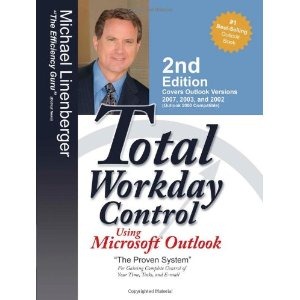You’re busy, you have trouble remembering everything on your to-do list, and you’re overwhelmed with email. Of course you are! It’s like writing a horoscope or a fortune cookie – the same things are true for everyone.
If Microsoft Outlook is one of the main tools you use to do your job, you should consider spending a few hours with Michael Linenberger’s book Total Workday Control Using Microsoft Outlook. A few simple changes to Outlook might increase your productivity and provide some peace of mind about your work load.
I did not expect ever to write words like that.
I don’t believe in books about efficiency and self-discipline and self-help. I don’t care Who Moved My Cheese. I don’t want to find out if I share any of the Seven Habits Of Highly Effective People. It’s just not my style, although I think it’s wonderful if people find those books inspiring or helpful. (Not always. Part of my cynicism about the future of civilization comes from knowing that The Secret became a best-seller instead of helping people heat their homes by using its pages for fuel, as it so richly deserves.)
Michael Linenberger has not written that kind of book.
Very few people use Outlook Tasks. Outlook’s strengths are obvious for calendar, contacts and mail, but it’s just not right for tasks and to-do lists. I tried for months to figure out the right system for a to-do list, dragging appointments from place to place on the calendar and being frustrated by the unintuitive views available in the task list.
The heart of Linenberger’s book is a step-by-step explanation of how to configure the task pane in Outlook, making it the center of your work day. There are detailed explanations of the various parts of Outlook’s task list and the specific settings to configure them in Outlook 2003 and Outlook 2007, but it is more than a software manual – along the way, you’re also learning why each part exists and how it contributes to the best practices of task and email management. Linenberger describes how to set up Outlook and goes on to provide concrete practical suggestions about how to implement his suggestions and what will happen as a result.
If you go through the first hundred pages of Total Workday Control with a copy of Outlook running nearby, reading and following instructions where necessary, you will have a system that tracks all of your tasks in Outlook, with complete confidence that nothing will be forgotten or overlooked; and you will have an empty Inbox every day.
I got my copy eight months ago and spent a couple of months working slowly through it, getting more interested all the time. I’ve been using its tips to manage my task list for most of 2010 and I’m in better control of my schedule and my to-do list than ever before.
There are acronyms and terms for segmenting tasks that left me a little cold, mostly in the second half of the book. (Manage to a “Now Horizon” and distinguish between “Target-Now” and “Opportunity-Now” tasks. Well, okay, whatever.) But the first half of the book is focused on the basics of task, calendar, and email management in a way that I found extraordinarily helpful.
If you’ll invest some time in learning how to use Outlook, you’ll get a handle on everything else in your life. It’s as simple as that. Read more about it, talk to me, then buy a copy of the book and roll up your sleeves! You will be well rewarded.
[My thanks to small business consultant and loyal client Mike Baldus, who first called my attention to Linenberger’s book.]


Trackbacks/Pingbacks